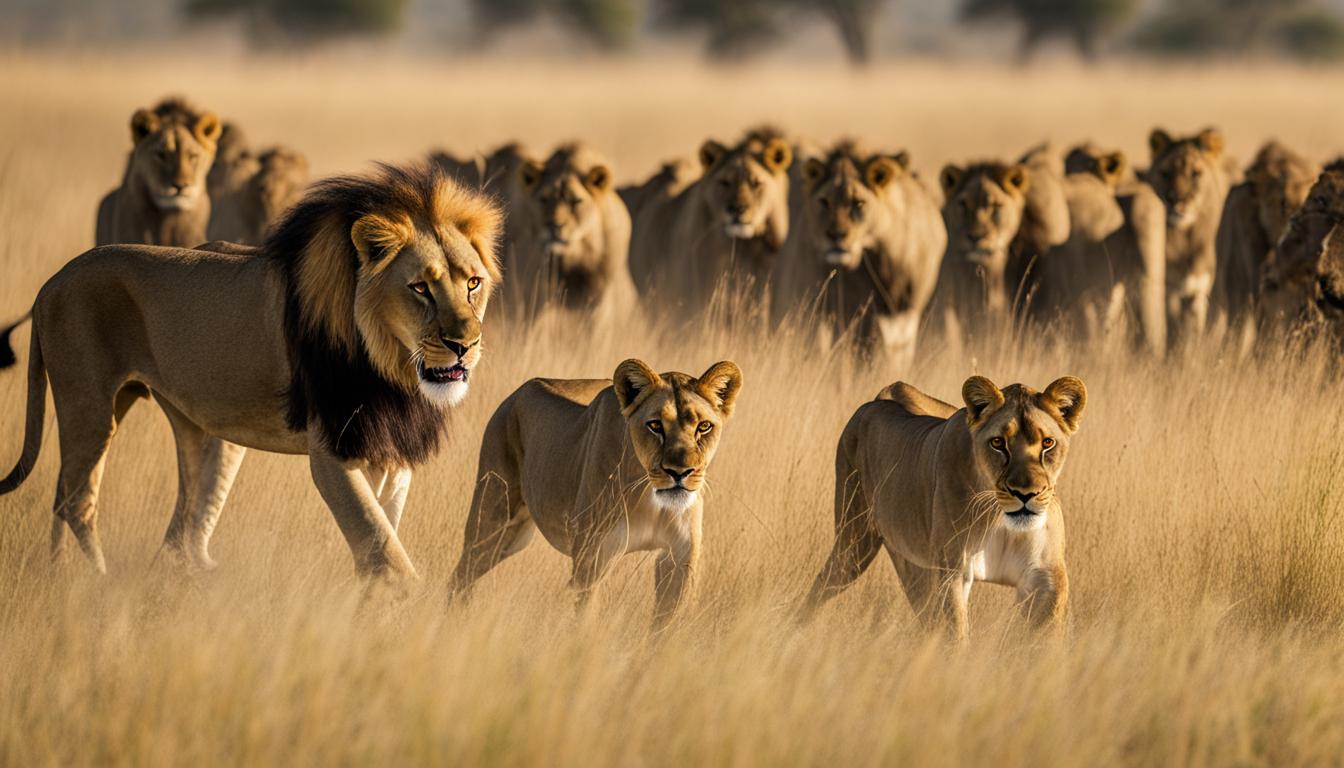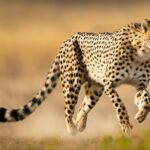Lions are efficient hunters known for their stalking techniques and hunting strategies. They have specific roles within their pride, with lionesses being the primary hunters. Lionesses are faster than male lions, reaching speeds of up to 45mph, and they often hunt in packs. Lions employ two main hunting methods: stalking and direct confrontation. Stalking involves staying hidden and approaching prey stealthily, while direct confrontation involves the male lion joining the hunt with the lionesses. The hunting strategy varies depending on the size and behavior of the prey.
Key Takeaways:
- Lion hunting involves specific roles within the pride, with lionesses being the primary hunters.
- Lionesses are faster than male lions, reaching speeds of up to 45mph.
- Lions use two main hunting methods: stalking and direct confrontation.
- Stalking involves staying hidden and approaching prey stealthily.
- Direct confrontation occurs when the male lion joins the hunt with the lionesses.
Lioness: The Main Hunter of the Pride
Female lions, known as lionesses, play a crucial role in hunting for the pride. Despite being smaller in size compared to male lions, lionesses compensate with their speed and agility. They are up to 30% faster than male lions and often work together in packs to increase their chances of a successful hunt. Lionesses use their slender bodies to stay hidden in the grass while stalking their prey. They surround the prey, and once it is noticed or hears their approach, a chase ensues until the lioness captures and subdues the prey with their powerful claws.
Lionesses form a strong bond within the pride and develop effective strategies to bring down their prey. Their cooperative hunting approach allows them to bring down larger animals that would be too challenging for an individual lioness. By working together, they can encircle the prey, cut off escape routes, and launch coordinated attacks. This synchronized hunting behavior demonstrates their exceptional communication and teamwork within the pride.
The lioness’s role as the main hunter highlights the importance of female cooperation and pack dynamics in securing a successful hunt for the pride. Their speed, agility, and strategic hunting techniques make them formidable predators on the African savannah.
Stalking: The Stealthy and Patient Approach
Stalking is the primary hunting method employed by lions, enabling them to approach their prey stealthily and patiently. Just like domestic cats, lions are masters of staying hidden and waiting for the perfect opportunity to strike. Lionesses, with their slimmer bodies, have a remarkable ability to blend into the tall grass, remaining unseen for extended periods. This patient approach allows them to get as close as possible to their unsuspecting prey before initiating the chase.
“Stalking is a crucial aspect of lion hunting. It requires immense patience and careful coordination within the pride. By staying hidden and meticulously observing their prey, lions increase their chances of a successful hunt,” says Dr. Samantha Turner, a wildlife biologist.
During a hunt, lionesses often work together, employing strategic coordination to surround the prey from different angles. This collaborative effort ensures that the prey has limited escape options, making it more likely for the lionesses to capture and subdue their target. Once the prey becomes aware of the approaching lionesses or hears their stealthy movements, a high-speed chase begins, unleashing the lion’s powerful claws to immobilize and deliver a fatal blow.
| Lion Stalking Tactics | Description |
|---|---|
| Invisibility | Lionesses use their slender bodies and natural camouflage to stay hidden in tall grass or bushes, making it difficult for prey to detect their presence. |
| Coordinated Approach | Lionesses work together in packs, surrounding the prey from different angles to minimize the chances of escape. |
| Stealthy Movements | Lionesses move slowly and silently, minimizing any noise that could alert the prey before initiating the chase. |
| Patience | Lionesses wait for the perfect moment to strike, ensuring they are within striking distance before launching their attack. |
Stalking: The Art of Patience and Precision
Stalking requires the art of patience and precision. Lions can wait for hours, observing their prey’s behavior and movements, to understand the optimal time to strike. Any sudden movement or noise can alert the prey and result in a failed hunt. It is this extraordinary patience that allows lions to get within striking distance undetected, increasing their chances of a successful hunt.
When you witness a lioness in stealth mode, moving silently and slowly, you can’t help but admire their calculated approach. Stalking is a testament to the lion’s evolution as an apex predator, showcasing their ability to adapt to different hunting scenarios and employ specialized tactics to secure a meal for the pride.
Direct Confrontation: The Male Lion’s Role in Hunting
While the female lionesses take on the majority of the hunting responsibilities, male lions also participate in hunts, particularly when it comes to hunting large prey. In these situations, there is no hiding or stalking involved. The male lion joins forces with the lionesses and strategically corners the prey. The outcome of the hunt depends on the weight, strength, and bravery of the male lion. This direct confrontation approach is typically used for larger prey like cape buffalos, zebras, and giraffes. It showcases the lion’s size, brute strength, and ability to overpower their prey.
The Male Lion’s Hunting Technique
When engaging in direct confrontation, male lions use their superior size and strength to their advantage. They rely on their massive bodies to intimidate and overpower the prey. The male lion’s role in hunting involves strategic positioning and coordinated teamwork with the lionesses. By strategically surrounding the prey, they minimize the escape routes and increase the chances of a successful hunt. Once the prey is cornered, the male lion can use its powerful jaws and sharp teeth to deliver a lethal bite, swiftly incapacitating the prey.
Table: Comparison of Male and Female Lions in Hunting
| Male Lion | Female Lioness | |
|---|---|---|
| Size | Larger and more muscular | Smaller and more agile |
| Role in Hunting | Assists in hunting large prey | Main hunter, particularly for small to medium-sized prey |
| Hunting Strategy | Direct confrontation | Stalking and stealthy approach |
| Strengths | Powerful bite force, intimidation | Speed, agility, teamwork |
| Prey Preference | Large herbivores | Wide range of prey, including small to medium-sized herbivores |
Direct confrontation allows male lions to target and take down large prey that may be challenging for the lionesses to handle alone. This hunting technique demonstrates the unique division of labor within a lion pride, where each member plays a crucial role in ensuring the survival and success of the group.
Lion Hunting Patterns and Strategies
Lions exhibit a variety of hunting patterns and strategies that are tailored to the characteristics of their prey. By understanding these tactics, we gain insight into the successful hunting tactics of these majestic creatures.
When it comes to hunting larger animals like zebras, cape buffalos, or wildebeests, lions employ a cooperative strategy. They encircle the herd, strategically targeting weaker or older individuals to increase their chances of a successful hunt. This coordinated approach enhances their hunting efficiency and ensures a higher success rate.
On the other hand, when hunting smaller prey such as warthogs, lions adopt a more cautious approach. They conceal themselves in the grass and patiently wait for the prey to come closer. Once the prey makes a run for it, lions utilize their speed and agility to swiftly capture and kill their target.
| Lion Hunting Patterns | Lion Hunting Strategies |
|---|---|
| Cooperative hunting in packs | Encircling herds and targeting weak or older individuals |
| Stealthy stalking | Concealing themselves in the grass before initiating the chase |
| Strategic ambush | Utilizing their speed and agility to capture smaller prey |
| Swift chase and take-down |
These hunting strategies are shaped by the size, behavior, and strength of their prey. Lions’ ability to adapt their hunting techniques showcases their intelligence and adaptability as apex predators.
Patience: A Key Element in Lion Hunting
Lions are renowned for their exceptional hunting prowess, and one key element that sets them apart is their remarkable patience. This attribute plays a vital role in their hunting success, particularly when it comes to stalking and ambushing prey. Lions have mastered the art of remaining hidden in the tall grass or behind bushes, waiting patiently for the perfect moment to strike.
During a hunt, lions employ stalking techniques to get as close as possible to their prey without being detected. They carefully observe the movements and behavior of their intended target, biding their time until they can launch a swift and decisive attack. This requires immense patience and self-control, as any sudden movement or premature action can alert the prey and lead to a failed hunt.
The patience exhibited by lions during the hunt is awe-inspiring. They can wait for hours, perfectly still and completely focused, waiting for the opportune moment to pounce. This level of patience allows lions to get within striking distance without alarming their prey, maximizing their chances of capturing their target successfully. It also showcases their incredible discipline and adaptability in the face of unpredictable hunting situations.
“Patience is not just a virtue, but a fundamental skill in the world of lion hunting. It is the ability to wait and choose the right moment that ultimately determines the success of a hunt. Lions have perfected this skill through years of evolution, and it is an integral part of their hunting strategy.”
The Role of Patience in Stalking
When lions employ stalking as their primary hunting method, patience is of utmost importance. Stalking requires lions to blend seamlessly into their surroundings, becoming one with the environment. This involves staying hidden and motionless for extended periods, patiently awaiting the perfect opportunity to strike. By closely monitoring and analyzing the behavior of their prey, lions can anticipate their movements and position themselves for a successful attack.
| Prey | Patience Required |
|---|---|
| Wildebeest | High |
| Gazelle | Moderate |
| Zebra | High |
| Warthog | Moderate |
This table illustrates the varying levels of patience required when stalking different prey. While some species may require a higher level of patience, lions are masters at adapting their hunting strategies to suit the behavior and movements of their intended target.
In conclusion, patience is an essential element in lion hunting. It enables lions to execute their stalking techniques effectively and increases their chances of a successful hunt. By harnessing their extraordinary patience and discipline, lions have become formidable hunters, securing their place at the top of the food chain.
Unique Hunting Patterns and Tactics
Lions are renowned for their unique hunting patterns and tactics, which distinguish them as skilled predators. Their hunting strategies demonstrate a high level of specialization and adaptability, enabling them to secure their place at the top of the food chain. Let’s explore some of the fascinating hunting techniques employed by these majestic creatures.
The Cooperative Hunting Strategy
One of the most distinctive hunting patterns of lions is their cooperative strategy. Lions are social animals that live in prides, typically consisting of multiple females, their offspring, and a few dominant males. When hunting, the lionesses work together in coordinated groups, utilizing intricate communication and teamwork to increase their chances of success. This cooperative approach involves encircling the prey, launching a synchronized attack, and strategically driving the prey towards waiting lions in ambush positions. Through this strategic hunting behavior, lions can overcome the challenges presented by large and formidable prey.
Specialized Hunting Techniques
Another remarkable aspect of lion hunting is their use of specialized techniques tailored to different hunting scenarios. Lions possess incredible strength and agility, allowing them to employ various tactics to capture their prey effectively. For instance, lions may use their powerful paws to knock down smaller or less stable prey, impairing their ability to escape. In the case of larger prey, lions may employ a combination of strength and strategy, leaping onto the back of the animal and wrestling it to the ground. These unique hunting techniques highlight the lion’s versatility and ingenuity in adapting to different hunting situations.
“Lions have honed their hunting skills over generations, capitalizing on their strength in numbers and a deep understanding of their prey’s behavior.” – Wildlife Expert
Their strategic hunting behavior has been honed over generations, enabling them to exploit the weaknesses and vulnerabilities of their prey. By observing and evaluating the behavior of their target, lions can devise effective strategies that maximize their chances of success. This level of specialization and adaptability sets lions apart as formidable hunters in the animal kingdom.
| Hunting Pattern | Description |
|---|---|
| Cooperative Hunting | Groups of lionesses work together to encircle and ambush prey. |
| Specialized Techniques | Lions use their strength and agility to employ various tactics depending on the size and behavior of their prey. |
| Strategic Behavior | Lions observe and understand their prey’s behavior to devise effective hunting strategies. |
As we delve into the world of lion hunting, we gain valuable insights into their unique patterns, specialized techniques, and strategic behavior. The intricate dynamics within a pride and the ability to adapt to different hunting scenarios make lions an extraordinary species to study. Their hunting prowess showcases the marvels of nature’s design and highlights the remarkable intelligence and sophistication of these magnificent creatures.
Conclusion
Lions have developed effective hunting strategies and tactics to secure their place at the top of the food chain. Female lionesses take on the primary hunting role, employing stalking techniques and working together in packs. They use their speed, agility, and coordination to increase their chances of a successful hunt.
Male lions, on the other hand, contribute to hunting by joining forces with lionesses to confront and overpower larger prey. Their size and strength play a crucial role in these direct confrontations, showcasing their dominance and ability to take down formidable opponents.
Patience, coordination, and an understanding of prey behavior are key components of lion hunting. Lions display exceptional patience, waiting silently in the grass for hours, carefully positioning themselves for the perfect moment to strike. Their ability to anticipate prey movements and adapt their hunting strategies accordingly is a testament to their skill as predators.
By studying and appreciating the hunting strategies of lions, we gain a unique insight into the fascinating world of these majestic creatures. Their hunting prowess highlights their exceptional adaptability, survival instincts, and the intricate dynamics within a pride. It is a reminder of the remarkable diversity and complexity of nature’s predators.
What Are the Types of Prey That Lions Typically Hunt?
Lions’ diet and hunting techniques revolve around preying on various animals. Their preferred prey includes large ungulates like zebras, wildebeests, and buffalo. However, they are adaptable hunters and can also target smaller mammals such as impalas and warthogs. Lions rely on their exceptional teamwork and strategic techniques to effectively hunt down their prey, optimizing their chances of a successful kill.
FAQ
What are the tactics lions use when hunting for prey?
Lions use a combination of stalking and direct confrontation techniques to hunt for prey. Stalking involves staying hidden and approaching prey stealthily, while direct confrontation involves the male lion joining the hunt with the lionesses. The hunting strategy varies depending on the size and behavior of the prey.
What is the role of lionesses in hunting?
Lionesses are the primary hunters in the pride. They are smaller in size compared to male lions but compensate with their speed and agility. Lionesses are up to 30% faster than male lions and often work together in packs to increase their chances of a successful hunt.
How do lions stalk their prey?
Lions employ a stalking method similar to domestic cats. They hide and stay hidden for as long as possible while approaching their prey. Lionesses, with their slimmer bodies, can stay hidden in the grass for extended periods. The primary goal of stalking is to get as close as possible without being noticed before initiating the chase.
What is the male lion’s role in hunting?
Male lions also participate in hunts, particularly when it comes to hunting large prey. In these situations, there is no hiding or stalking involved. The male lion joins forces with the lionesses and strategically corners the prey. The outcome of the hunt depends on the weight, strength, and bravery of the male lion.
What are the hunting patterns and strategies of lions?
Lions exhibit different hunting patterns and strategies depending on the size, strength, and behavior of their prey. They often employ a cooperative strategy, encircling the herd and targeting weaker individuals. When hunting smaller prey, lions use a more cautious approach, hiding in the grass and waiting for the prey to come close.
How important is patience in lion hunting?
Patience plays a vital role in lion hunting. Lions are known for their exceptional patience, especially when it comes to hunting faster prey. They stay hidden in the grass without making any sudden movements, waiting for extended periods until the prey comes closer.
What makes lion hunting patterns and tactics unique?
Lions have unique hunting patterns and tactics that set them apart from other predators. They employ cooperative hunting strategies, specialized hunting techniques such as using their paws to knock prey off balance, and jumping on larger prey to wrestle them to the ground.







